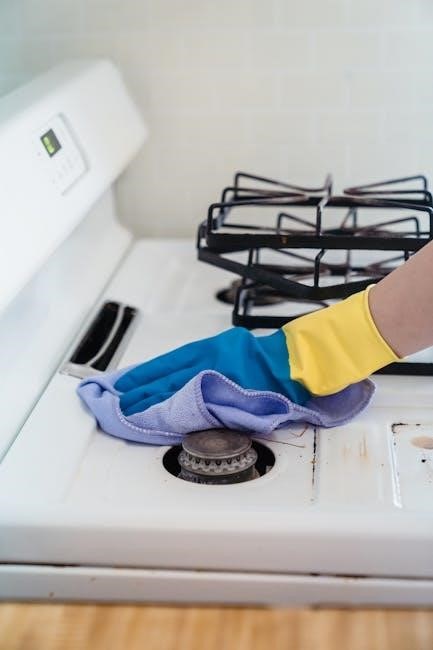GE Self-Cleaning Oven Instructions: A Comprehensive Guide
Discover the ease of maintaining a sparkling clean GE oven! This guide simplifies the self-cleaning process, offering step-by-step instructions and essential safety tips. Maximize your oven’s performance with our comprehensive overview, ensuring effortless maintenance and longevity for your appliance.
Understanding the GE Self-Cleaning Feature
The self-cleaning feature on your GE oven offers a convenient and efficient method for eliminating baked-on food residue without the need for harsh chemicals or intensive scrubbing. This function uses extremely high temperatures, reaching approximately 880 degrees Fahrenheit (471 degrees Celsius), to incinerate food particles and grease, reducing them to a small amount of ash that can be easily wiped away.
This process saves time and effort, ensuring a thorough cleaning of the entire oven interior, including those hard-to-reach spots. Understanding how this feature works is crucial for safe and effective use. The self-clean cycle is designed to simplify your kitchen maintenance, making oven cleaning less of a chore.

It is important to note that during the self-clean cycle, the oven door will automatically lock to prevent accidental opening due to the high temperatures inside. This safety feature ensures that no one is exposed to the extreme heat. The duration of the cycle can vary depending on the model and the level of cleaning required, typically ranging from one and a half to three hours. Proper ventilation is also recommended during the process to minimize any odors that may arise from burning food particles.
Key Features of a GE Self-Cleaning Oven

GE self-cleaning ovens boast several key features designed for convenience and efficiency. A primary feature is the high-temperature self-cleaning cycle, reaching approximately 880°F (471°C), effectively incinerating food soils and grease, leaving minimal ash for easy removal. Some models also include a steam clean option for quick cleaning of minor spills, offering a gentler alternative to the high-heat cycle.
An automatic oven door lock engages during the self-clean process, ensuring safety by preventing accidental opening while the oven is at high temperatures. Many GE ovens also incorporate a delay clean option, allowing you to schedule the self-clean cycle to start at a more convenient time.
Furthermore, cooling fans are often used to protect internal components during and after the self-cleaning cycle, extending the oven’s lifespan. Select models also feature variable self-clean cycle durations, enabling you to customize the cleaning intensity based on the level of soil. These features combine to provide a user-friendly and effective oven cleaning experience.
Preparing Your GE Oven for Self-Cleaning
Before initiating the self-clean cycle on your GE oven, thorough preparation is crucial. Begin by removing all oven racks, cookware, baking stones, and any aluminum foil. While some GE ovens feature self-clean racks, it’s generally recommended to remove all racks to prevent discoloration or damage from the intense heat.
Next, manually remove any large pieces of food debris from the oven floor and walls. This minimizes smoke and odors during the cleaning cycle. Avoid using commercial oven cleaners at this stage, as they can react negatively with the self-clean process.

Ensure proper ventilation by opening windows or turning on your kitchen exhaust fan. The self-clean cycle can produce fumes and odors, so good ventilation is essential for your comfort and safety. Finally, familiarize yourself with your specific GE oven model’s instructions for initiating the self-clean cycle, as button locations and settings may vary.
Initiating the Self-Clean Cycle on a GE Oven
Once your GE oven is prepped, initiating the self-clean cycle is a straightforward process. Locate the “Self-Clean” button on your oven’s control panel. Press this button to begin the cycle selection. Some models may require you to select a cleaning duration or intensity level.
Refer to your oven’s user manual for specific instructions regarding cycle duration, which typically ranges from one and a half to three hours, depending on the soil level. After setting the desired duration, the oven door will automatically lock for safety, preventing accidental opening during the high-temperature cleaning process.
A “Clean” or “Self-Clean” indicator light will illuminate, signaling that the cycle has begun. Avoid interrupting the cycle once it has started, as this can damage the oven. Allow the self-clean cycle to run its course without interference, ensuring optimal cleaning results. The oven will automatically shut off and unlock once the cycle is complete and the oven has cooled down.
Self-Clean Cycle Duration
The duration of the self-clean cycle on a GE oven is a key factor in achieving optimal cleaning results. Typically, the cycle lasts between one and a half to three hours, though specific times can vary based on the oven model and soil level. Lighter cleaning needs may only require a shorter cycle, while heavily soiled ovens will benefit from a longer duration.
Consult your oven’s user manual for the recommended self-clean cycle times. GE ovens often offer options for selecting the cleaning duration, allowing you to customize the cycle based on the amount of food residue. Keep in mind that the self-clean cycle includes both the high-temperature cleaning phase and a cool-down period.
Avoid interrupting the cycle prematurely, as this can hinder the cleaning process and potentially damage the oven. Allow the full cycle to complete, ensuring that all food soils are effectively incinerated. After the cycle finishes, the oven will automatically shut off and unlock, indicating it is safe to open the door.
The Self-Clean Process: What Happens Inside
The self-clean process in a GE oven is a remarkable feat of engineering, employing extreme heat to eliminate food residue. Once initiated, the oven’s temperature steadily climbs, often reaching scorching levels of up to 880-900 degrees Fahrenheit (471-482 degrees Celsius). This intense heat is the key to the entire cleaning operation.
At these elevated temperatures, any lingering food particles, grease splatters, and baked-on messes undergo a process called pyrolysis. Pyrolysis is the thermal decomposition of materials at high temperatures in an inert atmosphere. In the oven, this means that the organic food residue is broken down into its basic components, primarily carbon dioxide, water, and ash.
During the self-clean cycle, you might notice smoke and a distinct odor emanating from the oven. This is a normal part of the pyrolysis process as the food residue is being incinerated. Ensure proper ventilation by opening windows or turning on the exhaust fan to minimize any discomfort. The self-clean process is a powerful and efficient way to maintain a clean oven.
Cooling Down After the Self-Clean Cycle
Once the self-clean cycle completes its high-temperature work, the oven initiates a cool-down phase. This is a critical part of the process, as it ensures the oven’s internal components return to a safe temperature before you can access the interior. The cooling period can vary, typically lasting between 30 to 90 minutes, depending on the specific GE oven model and the duration of the self-clean cycle.
During the cool-down, a fan might run to help dissipate the heat, this is a normal operation. Avoid the temptation to manually override or expedite this process, as it could potentially damage the oven’s sensitive components.
Only after the oven has fully cooled down and the door lock has disengaged is it safe to open the oven door and address the remaining ash. Patience is vital during the cool-down phase to ensure both your safety and the longevity of your GE oven.
Dealing with Odors During Self-Cleaning
The self-cleaning process in a GE oven involves extremely high temperatures, which can sometimes lead to noticeable odors. These odors are typically caused by the burning off of accumulated food residue, grease, and spills within the oven cavity. While some level of odor is normal, especially during the first few self-cleaning cycles, taking certain precautions can help minimize and manage them.
Ensure proper ventilation by opening windows and turning on the kitchen exhaust fan. This helps to circulate fresh air and remove any lingering smells. If the odor becomes excessively strong or unusual, consider pausing the self-clean cycle and inspecting the oven for large spills or debris. Removing these beforehand can lessen the intensity of odors.
Following these steps allows for a more pleasant experience during the self-cleaning process, ensuring a fresh-smelling kitchen.
Removing Ash After Self-Cleaning
Once the self-cleaning cycle of your GE oven has completed and the oven has fully cooled down, the next step is to remove the residual ash. This ash is the byproduct of the high-temperature incineration of food particles and grease that accumulated during cooking. Removing this ash is essential for maintaining the cleanliness and optimal performance of your oven.
Use a damp cloth or sponge to gently wipe down all interior surfaces of the oven, including the walls, floor, and door. Pay close attention to corners and crevices where ash may have accumulated. For stubborn areas, a non-abrasive cleaning pad can be used with gentle pressure.
After wiping down the oven, ensure all ash residue is removed, promoting a clean cooking environment for future use. This simple step contributes to the longevity and efficiency of your GE oven.
Cleaning Oven Racks Separately
While your GE oven’s self-cleaning cycle works wonders on the interior, the oven racks require a separate cleaning approach. The high heat of the self-clean cycle can sometimes discolor or damage the racks, so it’s best to remove them before initiating the cycle. However, some GE models have self-clean racks that are safe to leave inside.
To clean the racks, you can soak them in a solution of warm water and dish soap in a large sink or tub. Let them soak for at least 30 minutes to loosen any baked-on food particles. For tougher stains, you can use a non-abrasive scrub brush or sponge to gently scrub the racks.
After scrubbing, rinse the racks thoroughly with clean water and allow them to air dry completely before placing them back into the oven. This ensures that no moisture is trapped, which could lead to rust or corrosion. Keeping your oven racks clean not only improves their appearance but also ensures they function properly for years to come;
Safety Precautions During Self-Cleaning

The self-cleaning function on your GE oven operates at extremely high temperatures, so it’s crucial to take necessary safety precautions. Never leave the oven unattended during the self-cleaning cycle, and keep children and pets away from the kitchen to prevent accidental burns. Ensure the kitchen is well-ventilated by opening windows and turning on the exhaust fan to minimize the build-up of fumes.
Avoid touching the oven’s exterior during the cycle, as it will become very hot. If you need to check on the oven, use oven mitts or heat-resistant gloves. Be aware that some smoke and odors are normal during the self-cleaning process, but excessive smoke or strong, unusual odors could indicate a problem.
In such cases, immediately turn off the oven and consult the owner’s manual or contact GE customer support. Remember to allow the oven to cool down completely before opening the door and removing any ash. Following these safety precautions will help ensure a safe and worry-free self-cleaning experience.
Alternative Cleaning Options: Steam Clean
If you’re looking for a gentler cleaning method than the high-heat self-clean cycle, explore the steam clean option available on some GE oven models. Steam clean is ideal for light spills and messes, providing a quicker and more energy-efficient alternative. To use the steam clean function, start by removing all oven racks and accessories.
Then, pour about one cup of water into the bottom of the oven cavity. Close the oven door and select the “Steam Clean” setting on the control panel. The oven will heat the water, creating steam that loosens dirt and grime. The steam clean cycle typically lasts around 20-30 minutes. Once the cycle is complete, allow the oven to cool slightly before wiping away the loosened residue with a damp cloth or sponge.
This method is particularly useful for regular maintenance and preventing buildup, without the intense heat and potential odors associated with self-cleaning. Remember to consult your oven’s manual for specific instructions and recommended water amounts.
Troubleshooting Common Self-Cleaning Issues
Encountering issues during the self-cleaning cycle? Let’s address some common problems. If your oven isn’t starting the self-clean cycle, ensure the door is fully closed and the lock is engaged. A faulty door switch might prevent activation; consult a technician if needed. Excessive smoke during cleaning often indicates large food debris; remove any significant spills before initiating the cycle.
Unusual odors can arise from burnt-on residue; ventilate your kitchen well. If the self-clean cycle stops prematurely, power outages or overheating could be the cause. Allow the oven to cool completely before restarting. Error codes displayed on the control panel indicate specific malfunctions; consult your GE oven’s manual for troubleshooting steps;
If problems persist, contacting GE appliance support or a qualified repair technician is recommended. Avoid forcing the oven door open during the cycle, as this could damage the locking mechanism. Regular maintenance and prompt attention to issues ensure a smooth self-cleaning experience.
